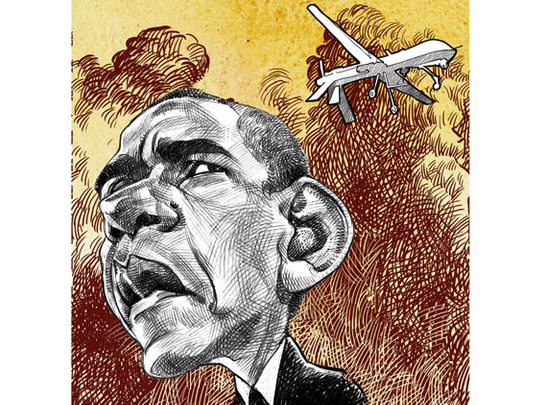
The past two weeks have seen an escalation in drone strikes more dramatic than any since 2009.
The media estimate that more than 37 people have died in a series of strikes in Yemen. The US government has refused to officially acknowledge the strikes surge or reports of potentially unlawful deaths just as it did, for years, refuse to confirm reports of the more than 300 drone strikes in Pakistan. On drones, secrecy is business as usual and it carries on.
Earlier this summer, however, there was hope for a different way forward. In late May, the White House released more information about US drone strikes than it ever had before. Following a major address on national security by President Barack Obama, the government pledged to keep sharing “as much information as possible”.
In fact, since May, the White House has not officially released any new information on drone strikes (though leaks still abound). While National Security Agency (NSA) surveillance has taken centre stage, the government’s policy of secrecy and obfuscation on drones persists, too. Past critics of the drone programme, ranging from Senator Rand Paul (Republican, Kentucky) to Senator Ron Wyden (Democrat, Oregon), should take notice. It is time to renew and expand the demand for answers about who is being killed.
Instead of acknowledging the new strikes and describing a coherent policy and legal approach, the government has again chosen to selectively disclose information that raises more questions than it answers. Thus, an unattributed leak to the New York Times last Monday served up a major policy change in the form of a morsel, with little elaboration, that a recent terrorist threat has “expanded the scope of people we could go after”.
So, the question of whom the US believes it can kill in drone strikes remains, as it ever was, full of unknowns. A handful of bullet-points on the government’s “policy standards” for using lethal force, which the White House released in May concurrently with the president’s national security speech, initially appeared to provide some guidance. But it expressly does not apply in “extraordinary circumstances”, and since the embassy closures of earlier this month could be interpreted as providing such justification, the memorandum may not be relevant to the latest spate of strikes in Yemen.
The White House could clarify this issue; better yet, it could move beyond conveniently malleable policy standards and describe how the government applies existing international law. Instead, the White House has again chosen to operate secretly and under rules of its own creation, which may permit killing individuals under a concept of “imminence” (of threat) that departs radically from all conventional interpretations of the law.
Even more damning is that, in the absence of any commitment to investigating credible allegations of unlawful deaths, the US appears indifferent to the question of who is actually dying in drone strikes. Obama admitted in May that four US citizens had been killed, three of whom — including 16-year-old Abdul Rahman Al Awlaki — he admitted were not intended targets. But the president did not define the identities of the more than 4,000 other people killed, or specifically address, reports that a significant number of the dead — in assessments varying between 400 and nearly 1,000, according to the Bureau of Investigative Journalism — were civilians.
When the president acknowledges four deaths of US citizens, but not 4,000 deaths of non-Americans, he signals to the world a callous and discriminatory disregard for human life. Perhaps only a fraction of these 4,000 deaths were unlawful. But acknowledging and investigating these deaths is a matter of dignity and justice for the survivors of strikes, their communities and their countrymen.
When deaths are found to be unlawful, victims’ families and survivors have a right to reparation. Refusing to investigate deaths is a matter of disrespect both for international law and for the public’s right to know the full truth.
Many critics, before Obama’s May address, feared that foreign governments would follow the US to lead and conduct secret drone strikes without regard for international law. They should still be concerned about the precedent the US government is setting: Refusing to investigate or be held accountable for wrongful deaths.
The risk now is not just that the late May reforms on drone strikes were half-measures, but that they were calibrated to merely reassure the public, defuse criticism and avert longer, harder scrutiny of whether the government’s actions are lawful and right. A token dose of transparency may remove the sting of government secrecy, but it does not cure the disease.
— Guardian News & Media Ltd
Naureen Shah is an advocacy adviser at Amnesty International USA and author of several studies on the impact of US drone strikes.










